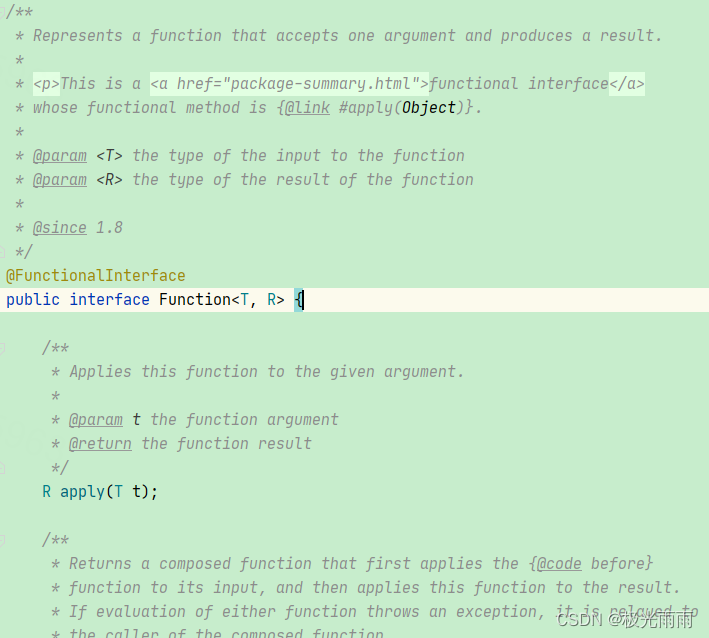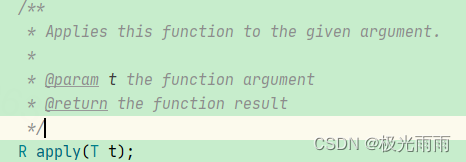Function 实际作用以及个人理解
在正常使用中,我们平时定义方法都是类似这样
public static String fixStringLength(String numberArg){
int length = numberArg.length();
switch (length){
case 1:
return "00"+numberArg;
default:
return "fix" + numberArg;
}
}
然后通过在其他代码中引用改方法来使用,例如:
public static void main(String[] args) {
fixStringLength("486");
}
Stream 中的 Function 实际上解决了一个简单的问题,那就是我们在实际书写代码的时候,一个方法一般只能作为代码中的某一行函数,用于处理里面的数值,但是并不能将一个方法作为一个参数,将方法以参数的形式将方法传递到下一个方法中继续使用。
源码以及使用示例

Function 是作为一种方法接口,两个泛型 T, R 在这里分别指代的是 方法的入参以及返回值的泛型。
1. apply

apply 的作用为执行当前方法函数,t 为入参,R 为返回值类型
示例:
public static void main(String[] args) {
// 定义函数 但没有创建实际方法而是类似于将方法 这里的 function1 作为一个变量,对象 以此来直接在行内引用方法对象 达到和方法一样的效果
Function<Integer, String> function1 = item -> {
item *= 100;
return item + "";
};
String apply = function1.apply(13);
System.out.println("apply = " + apply);
}
结果如下:

2. compose

compose 看内部实现,这个方法的入参也为 Function 类型,当调用时会先执行 作为入参的 Function 中的apply 方法,再将计算的结果作为原有方法的 apply 入参
示例:
public static void main(String[] args) {
// 定义函数 但没有创建实际方法而是类似于将方法 这里的 function1 作为一个变量,对象 以此来直接在行内引用方法对象 达到和方法一样的效果
Function<Integer, String> function1 = item -> {
item *= 100;
return item + "";
};
String apply = function1.apply(13);
System.out.println("apply = " + apply);
// 定义的第二个方法函数
Function<Integer, Integer> function2 = item -> item + 10;
// 先将 13 作为function2的入参 然后将结果作为function1的入参继续计算
String apply2 = function1.compose(function2).apply(13);
System.out.println("apply2 = " + apply2);
}
结果如下:

3. andThen

andThen 与compose 类似,但是方向相反
示例:
public static void main(String[] args) {
// 定义函数 但没有创建实际方法而是类似于将方法 这里的 function1 作为一个变量,对象 以此来直接在行内引用方法对象 达到和方法一样的效果
Function<Integer, String> function1 = item -> {
item *= 100;
return item + "";
};
String apply = function1.apply(13);
System.out.println("apply = " + apply);
// 定义的第二个方法函数
Function<Integer, Integer> function2 = item -> item + 10;
// 先将 13 作为function2的入参 然后将结果作为function1的入参继续计算
String apply2 = function1.compose(function2).apply(13);
System.out.println("apply2 = " + apply2);
// 定义的第三个方法函数
Function<String, Integer> function3 = item -> Integer.valueOf(item) + 31;
// 先将 13 作为function1的入参 然后将结果作为function3的入参继续计算
Integer apply3 = function1.andThen(function3).apply(13);
System.out.println("apply3 = " + apply3);
// 使用其他已定义的方法 示例
String apply4 = function1.andThen(App::fixStringLength).apply(13);
System.out.println("apply4 = " + apply4);
}
结果如下:
